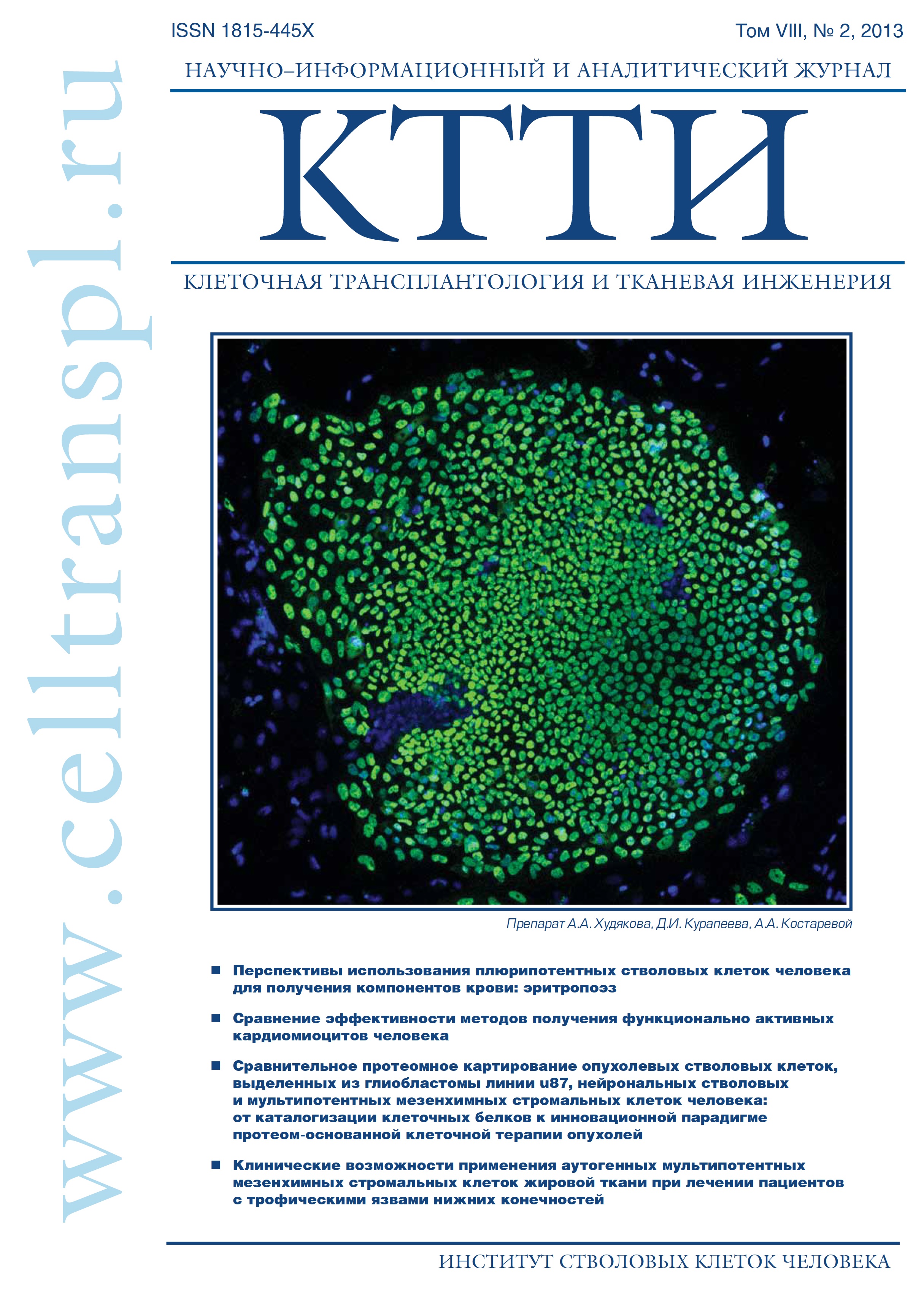Comparison of different methods for generation of functional human cardiomyocytes
- Authors: Khudiakov A.A1, Kurapeev D.I1, Kostareva A.A1, Malashicheva A.B1
-
Affiliations:
- Federal Almazov heart blood and endocrinology centre, Saint-Petersburg
- Issue: Vol 8, No 2 (2013)
- Pages: 47-55
- Section: Articles
- URL: https://genescells.ru/2313-1829/article/view/121604
- DOI: https://doi.org/10.23868/gc121604
- ID: 121604
Cite item
Abstract
Generation of human cardiomyocytes in vitro is important for basic science and for regenerative medicine. There are a lot of published protocols describing the cardiomyocytes obtaining with different efficacy. However in practice, a researcher is faced with the fact that published methods have to be adapted to a particular laboratory for specific tasks. The aim of this study was to compare three methods for generation of human cardiomyocytes in vitro: 1) from human adult heart sample by purifying myocardial progenitor cells and their subsequent differentiation into cardiomyocyte direction; 2) from human adipose tissue multipotent mesenchimal stromal cells (AT-MSC); 3) from human dermal fibroblasts using reprogramming technology and subsequent differentiation to cardiomyocytes. We have shown relatively low efficiency of cardiac progenitor cells and AT-MSC capacity to give rise to cardiomyocyte lineage. The effectiveness of cardiomyocytes differentiation from dermal fibroblasts by reprogramming technology was significantly higher. The advantages, disadvantages and perspectives of each method are discussed.
Keywords
Full Text
About the authors
A. A Khudiakov
Federal Almazov heart blood and endocrinology centre, Saint-Petersburg
D. I Kurapeev
Federal Almazov heart blood and endocrinology centre, Saint-Petersburg
A. A Kostareva
Federal Almazov heart blood and endocrinology centre, Saint-Petersburg
A. B Malashicheva
Federal Almazov heart blood and endocrinology centre, Saint-Petersburg
References
- Jacobson S.L. Culture of spontaneously contracting myocardial cells from adult rats. Cell Structure and Function 1977; 2: 1—9.
- Mitcheson, J.S., Hancox, J.C., Levi, A.J. Cultured adult cardiac myocytes: future applications, culture methods, morphological and electrophysiological properties. Cardiovascular Research 1998; 39(2): 280-300.
- Makino S., Fukuda K., Miyoshi S. et al. Cardiomyocytes can be generated from marrow stromal cells in vitro. J. Olinic. Investig. 1999; 103(5): 697-705.
- Badorff C., Brandes R.P., Popp R. et al. Transdifferentiation of blood-derived human adult endothelial progenitor cells into functionally active cardiomyocytes. Circulation 2003; 107(7): 1024-32.
- Bearzi C., Rota M., Hosoda T. et al. Human cardiac stem cells. PNAS USA 2007; 104(35): 14068-73.
- Smits A.M., van Vliet P., Metz C.H. et al. Human cardiomyocyte progenitor cells differentiate into functional mature cardiomyocytes: an in vitro model for studying human cardiac physiology and pathophysiology. Nature Protocols 2009; 4(2): 232-43.
- Takamiya M., Haider K.H., Ashraf M. Identification and characterization of a novel multipotent sub-population of Sca-1 cardiac progenitor cells for myocardial regeneration. PLoS One 2011; 6(9): 1-11.
- Planat-Benard V., Menard C., Andre M. et al. Spontaneous cardiomyocyte differentiation from adipose tissue stroma cells. Circulation Research 2004; 94(2): 223-9.
- Antonitsis P., Ioannidou-Papagiannaki E., Kaidoglou A. et al. Cardiomyogenic potential of human adult bone marrow mesenchymal stem cells in vitro. Thorac. Cardiovasc. Surg. 2008; 56(2): 77-82.
- van Dijk A., Niessen H.W., Zandieh Doulabi B. et al. Differentiation of human adipose-derived stem cells towards cardiomyocytes is facilitated by laminin. Cell Tissue Research 2008; 334(3): 457-67.
- Kehat I., Kenyagin-Karsenti D., Snir M. et al. Human embryonic stem cells can differentiate into myocytes with structural and functional properties of cardiomyocytes. J. Clinic. Investig. 2001; 108(3): 407-14.
- Xu C., Police S., Rao N. et al. Characterization and enrichment of cardiomyocytes derived from human embryonic stem cells. Circulation Research 2002; 91(6): 501-8.
- Thomson J.A., Itskovitz-Eldor J., Shapiro S.S. et al. Embryonic stem cell lines derived from human blastocysts. Science 1998; 282(5391): 1145-7.
- Takahashi K., Yamanaka S. Induction of pluripotent stem cells from mouse embryonic and adult fibroblast cultures by defined factors. Cell 2006; 126(4): 663-76.
- Yu J., Vodyanik M.A., Smuga-Otto K. Induced pluripotent stem cell lines derived from human somatic cells. Science 2007; 318(5858): 1917-20.
- Haase A., Olmer R., Schwanke K. et al. Generation of induced pluripotent stem cells from human cord blood. Cell Stem Cell 2009; 5(4): 434-41.
- Zuk P.A., Zhu M., Mizuno H. et al. Multilineage cells from human adipose tissue: implications for cell-based therapies. Tissue Engineering 2001; 7(2): 211-26.
- Streckfuss-Bomeke K., Wolf F., Azizian A. Comparative study of human-induced pluripotent stem cells derived from bone marrow cells, hair keratinocytes, and skin fibroblasts. European heart journal 2012; Epub. ahead of print.
- Юдинцева Н.М., Блинова М.И., Пинаев Г.П. Особенности организации цитоскелета у фибробластов нормальной, рубцовой и эмбриональной кожи человека, распластанных на белках внеклеточного матрикса. Цитология 2008; 50(10): 861-7.
- Graichen R., Xu X., Braam S.R. et al. Enhanced cardiomyogenesis of human embryonic stem cells by a small molecular inhibitor of p38 MAPK. Differentiation 2008; 76(4): 357-70.
- Martin-Rendon E., Sweeney D., Lu F. et al. 5-Azacytidine-treated human mesenchymal stem/progenitor cells derived from umbilical cord, cord blood and bone marrow do not generate cardiomyocytes in vitro at high frequencies. Vox sanguinis 2008; 95(2): 137-48.
- Oh H., Bradfute S.B., Gallardo T.D. et al. Cardiac progenitor cells from adult myocardium: homing, differentiation, and fusion after infarction. PNAS USA 2003; 100(21): 12313-8.
- He X.Q., Chen M.S., Li S.H. et al. Co-culture with cardiomyocytes enhanced the myogenic conversion of mesenchymal stromal cells in a dose-dependent manner. Mol. Cell Biochem. 2010; 339(1-2): 89-98.
- Wei F., Wang T., Liu J. et al. The subpopulation of mesenchymal stem cells that differentiate toward cardiomyocytes is cardiac progenitor cells. Exper. Cell Res. 2011; 317(18): 2661-70.
- Beier J.P., Bitto F.F., Lange C et al. Myogenic differentiation of mesenchymal stem cells co-cultured with primary myoblasts. Cell Biol. Internat. 2011; 35(4): 397-406.
- Bollini S., Smart N., Riley P.R. Resident cardiac progenitor cells: at the heart of regeneration. J. Mol. Cell Cardiol. 2011; 50(2): 296-303.
- Zhang J., Wilson G.F., Soerens A.G. et al. Functional cardiomyocytes derived from human induced pluripotent stem cells. Circulation Research 2009; 104(4): 30-41.
- Mummery C.L., Zhang J., Ng E.S. et al. Differentiation of human embryonic stem cells and induced pluripotent stem cells to cardiomyocytes: a methods overview. Circulation Research 2012; 111(3): 344-58.
Supplementary files










